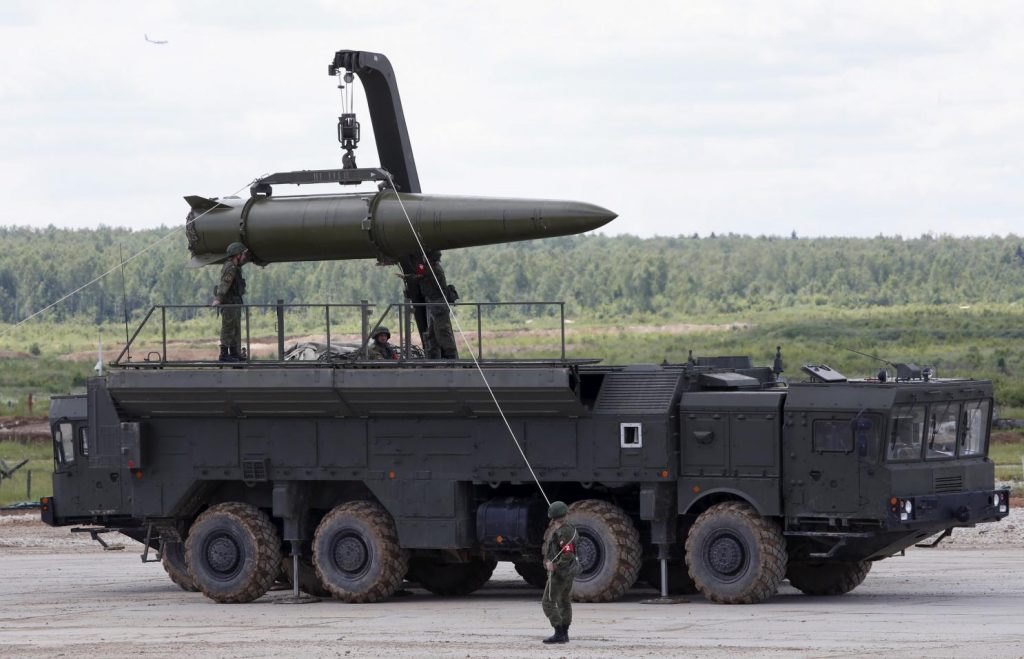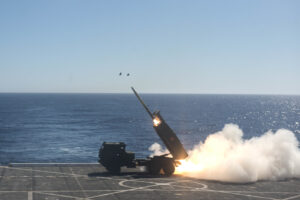US Sees Little Chance To Save INF Treaty Days Before Deadline
Posted on

A Russian 9M729 Novator ground-based cruise missile, which violates the INF treaty.
WASHINGTON: A top State Department official is not hopeful but says she is ready to continue talks about the Intermediate Nuclear Forces Treaty (INF) with the Russians on the sidelines of a United Nations summit in Beijing next week.
Just back from a unsuccessful round of discussions with her Russian counterparts in Geneva to discuss the Cold war-era accord, Undersecretary of State Andrea Thompson told reporters here Thursday she’s not hopeful of saving the deal before Feb. 2, when time runs out on the 60 days the Trump administration have given Moscow to acknowledge it had violated the pact.
“We didn’t break any new ground” in Geneva, Thompson said. “There was no new information. The Russians acknowledged having the system but continued to say in their talking points it didn’t violate the INF treaty despite showing them, repeated times, the intelligence and information” to the contrary.
“They’ve already deployed, manned and equipped entire battalions, it’s in the field,” Thompson said Thursday. “It can range our European partners today. If it continues to develop, we assess it will be able to range other regions as well.”
If there is no breakthrough, the US will formally announce on Feb. 2 that it is beginning the six-month notification process to withdraw from the treaty, meaning the Pentagon can begin fielding ground-based intermediate-range cruise missiles by Aug. 2 of this year.
The 1987 pact banned ground-launched missiles with ranges of 310 miles to 3,400 miles. The Obama and Trump administrations have slammed Russia for violating the pact. Both administrations said they have presented evidence to Russia that its Novator 9M729 missile breaks the agreed-upon range limitations.
Russia has long countered that long-range armed American drones, along with its Aegis Ashore missile defense system in Romania — and soon, Poland — also violates the treaty, a charge Washington and NATO allies say is baseless. Russia, in turn, argues that its own disputed missile can only reach a distance of about 300 miles — 10 miles under the limit. But the Americans and their NATO and non-NATO European allies say that claim is absurd, and have reportedly shown the Russians evidence they have disputing the claim.
Russia, in turn, denies it has been given any evidence by the Americans to buttress their claims.
Asked if she felt that the upcoming talks in Beijing might yield a breakthrough, Thompson said “if the past gives any indication of the future actions…the trend analysis, the pattern analysis would tell you that they’re probably not going to change.”
In December, the Trump administration gave Moscow 60 days to provide evidence that it would comply with the treaty before starting the process of pulling out. Given the six month wait time the treaty imposes before intermediate-range missiles can be fielded on withdrawal from the treaty, Aug. 2 would be the day when all Cold War-era bets are off.
One system that could be well on its way to production is the Marine Corps’ Navy-Marine Expeditionary Ship Interdiction System — or NEMSIS — which defense industry officials recently described to Breaking Defense.

A Marine HIMARS missile launcher fires from the deck of the USS Anchorage.
The rapid development program is being designed to begin firing long-range anti-ship missiles from shore-based ground vehicles at ranges that are banned by the treaty. The Marines are considering Lockheed Martin’s new Long-Range Anti-Ship Missile (LRASM), which a range disclosed only as “over 200 miles,” Raytheon’s Naval Strike Missile, and Boeing’s Harpoon.
“It’s clever of the Marine Corps to pursue a modern munition like LRASM that is already in production,” said Eric Sayers, adjunct senior fellow at CNAS and former Special Assistant at INDOPACOM. The missile has the potential to reach INF-ranges when launched from the ground, and can be integrated on an existing ground vehicle.
“This would give the INDPACOM Commander the ability to deploy a ground-based anti-ship missile in a matter of years, seriously complicating [Chinese] planning,” Sayers added. “The U.S. faces the operational dilemma of projecting power across Asia’s vast geography and an uncertain budget future. To me, this is the best, most affordable, near-term way to add credible combat power to the theater.”
The Army has also been developing its own ground-launched missiles that can smack targets in the currently banned ranges. By the spring, however, Army planners can likely start planning to introduce those weapons into the force.
The United States has been quietly planning for the possibility of leaving the treaty for years, as Breaking Defense first reported. A study conducted by the Joint Staff and Strategic Command makes clear that as far back as 2013 — a year before the Obama administration first publicly complained about Russian violations of the treaty — the Defense Department was considering which technologies the US could develop should Washington walk away from the INF.
The report points to four ways the US could quickly develop and field missiles within the currently banned ranges, including modifications to existing short range or tactical weapon systems, forward-basing ground-launched cruise missiles, intermediate-range ballistic missiles, or ground-launched intermediate-range missiles with trajectory shaping vehicles.
Asked about the future of arms control agreements now that the INF appears headed to the dustbin of history, Thompson said this shouldn’t affect future negotiations of the New Start agreement between the United States and Russia.
But the violation of the INF treaty, if allowed to stand, would undermine all other arms control treaties. “The act of fielding a system that violates the treaty brought the demise of the treaty,” she said. “To not acknowledge it, and to continue to allow it, I think is an action that undermines arms control. You are now accepting a new norm and setting a precedent for new treaties – ‘I’ll sign a treaty with you but go ahead and violate it, field the system.’”
Subscribe to our newsletter
Promotions, new products and sales. Directly to your inbox.
